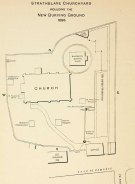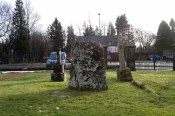Standing Stone: OS Grid Reference – NS 56387 79375
Also Known as:
From whichever direction you’re coming from along the A81 into Strathblane, make sure you keep your eyes peeled for where the A891 turns off it to the east. Go and along there and barely 100 yards on the church is set back from the road. Walk into the graveyard, turn left and you can’t really miss it amidst the mass of modern graves.
Archaeology & History
In accordance with the occasional tradition of standing stones in churchyards (such as the Rudston monolith and many others), a short stumpy monolith, less than four feet high, here stands alone in the christian burial ground surrounding Strathblane’s parish church. The top of the stone is quite flat and it’s possible that this once stood much taller, with the top of the stone being chopped off (such destruction has happened at the Cuckoo Stones and many other megalithic sites). It’s certainly worth looking at and stands amidst a cluster of other ancient sites—some gone, some still in evidence—in and around this lovely old village. Not much has been written about the stumpy little fella and its first literary reference seems to be in Mr Smith’s (1886) magnum opus on the area, where he tells:
“There is a very old standing stone in the churchyard, but most probably it was placed there long before there was any church in the parish.”
…Nothing else. Even the Royal Commission (1963) lads said little about it, merely telling us:
“A few yards within the entrance to the graveyard of Strathblane Parish Church…a standing stone appears among the monuments. It is a five-sided pillar, 3ft 9in high, with an uneven but flattish top. At ground level the sides range from 1ft 9ins to 2ft 3in in width.”
The fact that it stands by the church (rebuilt around 1803 out of its more ancient fabric) suggests that the site was a heathen temple or sacred site, redesignated by the invading christian priesthood. A short distant east and west have been found a number of prehistoric remains in the forms of burials, standing stones and giant cairns, indicating this site to have had particular mythic importance in earlier centuries. From the standing stone if we look southeast, we see the rise of Dunglass, but the view to the stones and great pyramid of Dumgoyach, northwest, is blocked by the rise of Cuilt Brae, which I found to be a little surprising.
References:
- Royal Commission on the Ancient & Historical Monuments Scotland, Stirling – volume 1, HMSO: Edinburgh 1963.
- Smith, John G., The Parish of Strathblane, James Maclehose: Glasgow 1886.
- Ure, David, The History of Rutherglen and East Kilbride, Glasgow 1793.
© Paul Bennett, The Northern Antiquarian
The map could not be loaded. Please contact the site owner.



